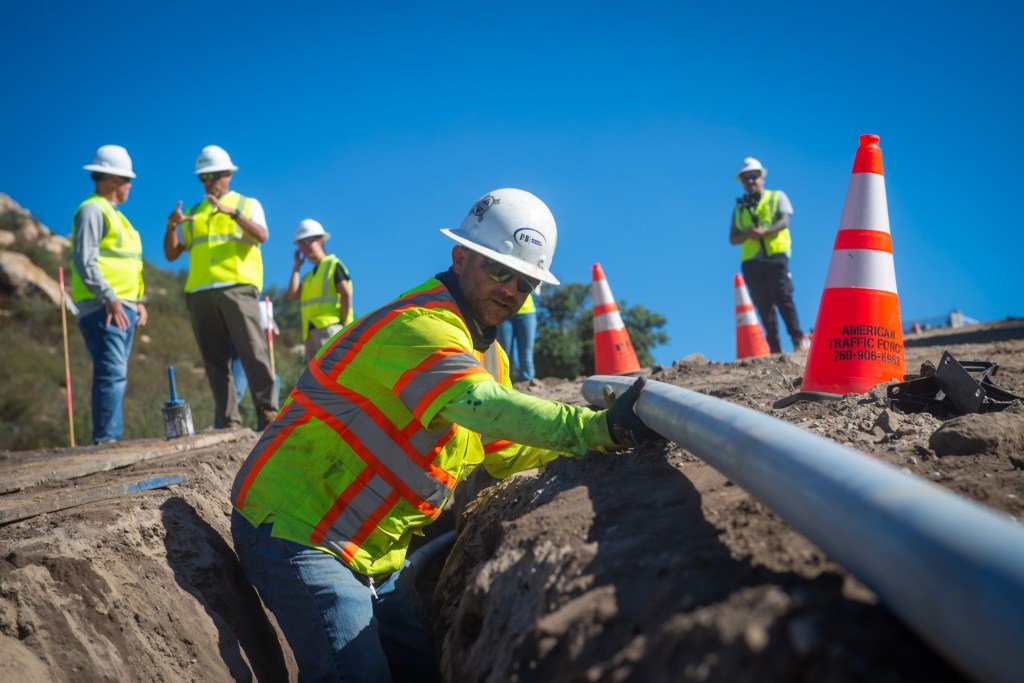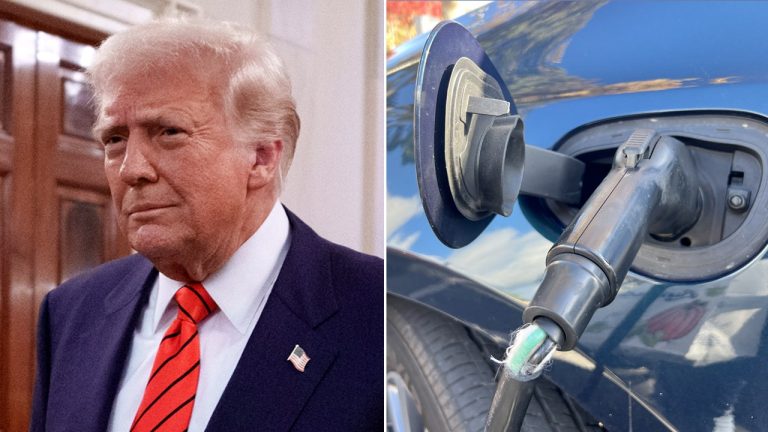
San Diego Gas & Electric officials want the California Public Utilities Commission to boost the miles of power lines the company is allowed to place underground as part of SDG&E’s efforts to reduce the risk of wildfires in the region.
But burying power lines is an expensive proposition and with customers in the San Diego area aching under the financial weight of ever-rising utility bills, it’s unclear whether the commission will make changes to a proposed decision it already issued last month.
“We are concerned that the decision underfunds some critical initiatives, particularly strategic undergrounding that we believe is the most cost-effective solution for reducing wildfire risk in San Diego County in those risky areas that primarily see winds over 50, 60 mph regularly,” said Caroline Winn, SDG&E’s chief executive officer.
More than 60% of SDG&E’s system is located in high-fire-threat districts that include large swaths of backcountry and rural communities that are vulnerable to falling power lines igniting a potential wildfire during dry and windy conditions.
One prevention method is to simply place the lines underground. It’s an effective, but pricey, effort that costs millions of dollars per mile.
Another option is placing covered conductors over existing overhead power lines. The insulated outer layer is designed to protect power lines from extreme weather conditions, damage from trees and potential wildfire ignition. It’s much less expensive than undergrounding but does not provide the same level of protection.

The amount SDG&E spends on wildfire mitigation is just one part of a sprawling four-year general rate case that’s about to be voted on by the utilities commission, known as the CPUC for short.
In its original submission, SDG&E asked the commission to approve $1.61 billion in ratepayer funds to underground 605 miles of power lines and $250.7 million to install 180 miles of covered conductors on existing overhead lines from 2024 through 2027.
But a number of consumer groups, including The Utility Reform Network, argued that SDG&E “overstates the annual wildfire risk in its service territory” and called for a less expensive plan that placed much more emphasis on covered conductors than burying power lines underground.
In part of a massive 1,105-page proposed decision issued last month, the CPUC sided with consumer advocates.
“The commission does not find it reasonable for SDG&E to spend as much as it proposes when its wildfire risk has decreased considerably in the last 15 years, and its rates have reached levels higher than other utilities in the state,” the decision said.
But a proposed decision is just that — a proposed decision. The final word on the general rate case will be made by the five commissioners of the CPUC, with a decision expected either Dec. 5 or Dec. 19. The voting members are free to accept, reject or make changes to the proposed decision.
After the proposed decision was issued, SDG&E submitted a compromise of sorts to the commission.
It now requests approval to place 400 miles of power lines underground (at an estimated cost of $2 million per mile) and 200 miles of covered conductor (estimated at $1 million per mile) over the course of four years. The total bill would come to around $1.04 billion (compared to the $1.9 billion that SDG&E originally asked for).
SDG&E argues that covered conductors do not provide the same level of protection as undergrounding does.
The utility also says burying more lines will reduce the number of public safety power shutoffs — the practice in which utilities cut off power to specific circuits (most often in backcountry communities) to reduce the chance of a downed power line igniting a wildfire when conditions are gusty and dry.
Plus, SDG&E officials claim undergrounding lines will eventually save ratepayers money by slashing the costs of maintaining overhead lines and vegetation management (such as tree-trimming) in the areas most prone to fires.
“We’ve already seen these overhead systems are causing ignitions,” said Brian D’Agostino, meteorologist and SDG&E’s vice president of wildfire and climate science. “We are setting ourselves up for a huge expense for our community in the future, so if we don’t take care of this now, it will cost more money in the long run, I believe.”
It’s hard to say how responsive the CPUC will be toward SDG&E’s new request.
The commission does not respond to comments that utilities, consumer groups or other parties make after a proposed decision is issued, but it’s clear the CPUC is increasingly sensitive to complaints about soaring utility bills.
In an interview with the Union-Tribune just days before the proposed decision was released, CPUC executive director Rachel Peterson said the decision amounts to “a balancing act” to help make sure SDG&E’s system remains reliable through 2027, adhering to the state’s decarbonization goals, while also keeping rising rates in mind.
“We really do take our job seriously as needing to ensure that investments in the electricity and gas systems are made,” Peterson said. “It’s just really unfortunate that at this moment in time, everything in California is so expensive and we’re fully aware of how utility bills are added on top of the general expense of living in California.”
According to the most recent report from the U.S. Bureau of Labor Statistics, San Diego had the highest price for electricity in the country in October, averaging 41.9 cents per kilowatt-hour.
SDG&E has spent about $6 billion of ratepayer dollars on a multitude of programs and investments to reduce the risk of wildfires since 2007.
In the fall of 2007, the devastating Witch Creek, Guejito and Rice wildfires destroyed more than 1,300 homes, killed two people, injured 40 firefighters and forced more than 10,000 to seek shelter at Qualcomm Stadium. One of the fires was caused by a tree limb that fell onto an SDG&E power line.
Since then, SDG&E created a weather network that includes 222 stations that measure wind speed, temperatures and humidity every 10 minutes. D’Agostino heads a team of six meteorologists that monitor more than 130 cameras that stream views of high-fire risk areas.







